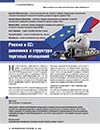Russia and the EU: Dynamics and Structure of Trade Relations
DOI: 10.33917/es-1.167.2020.36-41
The traditional and most developed form of international economic relations is foreign trade. This article analyzes the dynamics and structure of Russia’s foreign trade with the EU countries in the period from 2011 to 2018. It should be emphasized that external challenges not of an economic but of a political nature have led to the disruption of economic cooperation between the Russian Federation and the EU, including in the field of trade, which underlines the relevance of this study. The purpose of this study is to identify the impact of sanctions and counter-sanctions on the dynamics and structure of mutual trade between Russia and the EU
References:
|
1. Artemova E. I., Petrova A.Yu. Razvitie torgovykh otnoshenii Rossii i stran ES v usloviyakh geopoliticheskoi nestabil’nosti [Developing Trade Relations Between Russia and the EU Countries in the Context of Geopolitical Instability]. Nauchnyi zhurnal KubGAU, 2015, no 112. 2. Trade map, available at: https://www.trademap.org/ 3. UN Comtrade Database, available at: https://comtrade.un.org/data/ 4. TOP-5 Partners in International Trade in Goods. Eurostat, available at: https://ec.europa.eu/eurostat/web/international-trade-in-goods/visualisations. 5. Litvinova M. Vopreki sanktsiyam: v ES soobshchili o vosstanovlenii torgovli s Rossiei [Despite the Sanctions: EU has Declared Restoration of Trade with Russia]. Russia Today, 2017, December, 16, available at: https://russian.rt.com/world/article/461023-torgovlya-mezhdu-rossiei-i-es-vopreki-sankciyam. 6. Daniel’ G., Federika M. Vliyanie sanktsii i kontrsanktsii na torgovye potoki ES — Rossiya [The Impact of Sanctions and Counter-Sanctions on EU-Russia Trade Flows]. CEPS Commentary, 2016, July, 5, available at: https://www.ceps.eu/ceps-publications/effects-sanctions-and-countersanctions-eu-russian-trade-flows/ |



